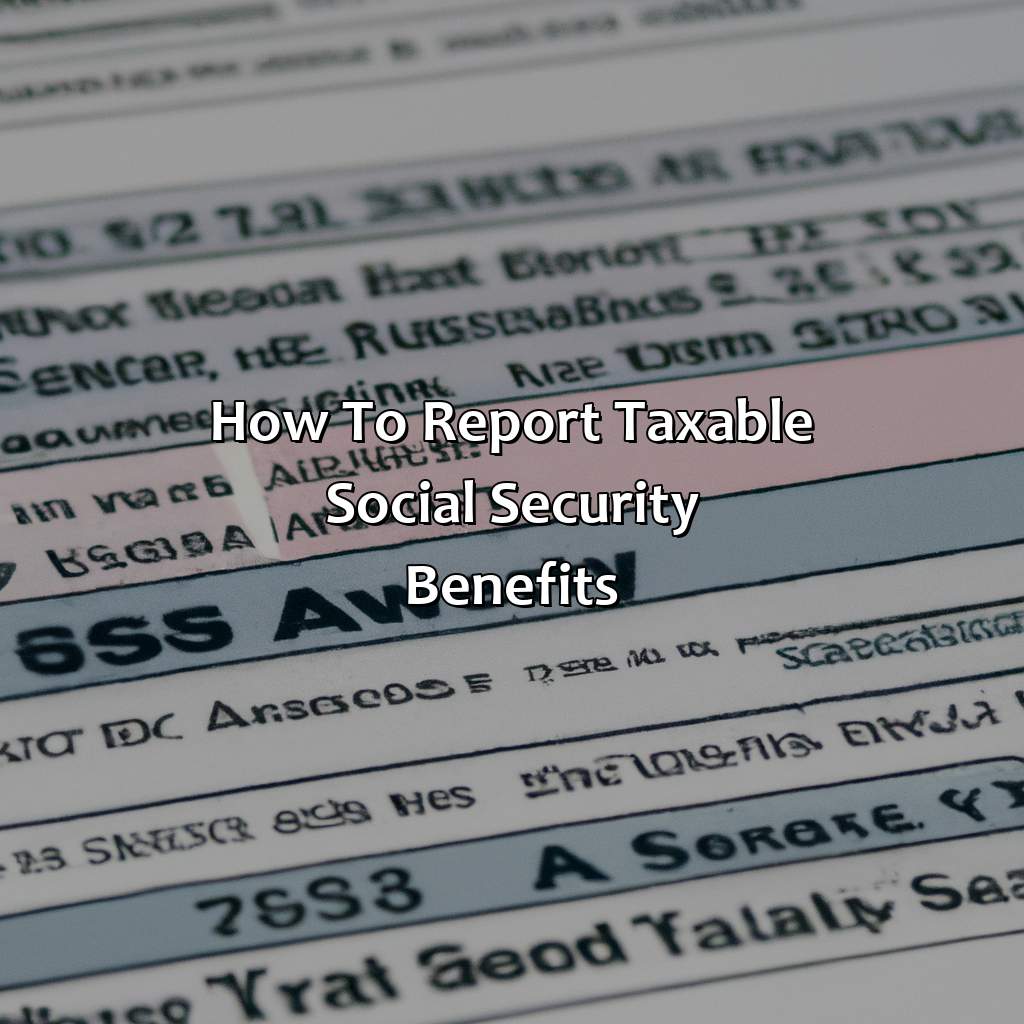What Is Taxable Social Security Benefits?
Key Takeaway:
- Social Security benefits refer to the payments made by the Social Security Administration to eligible individuals, including retirement, disability, and survivor benefits.
- Taxable Social Security benefits refer to the portion of these benefits that are subject to federal income taxes, which is determined based on the individual’s total income and filing status.
- Reporting taxable Social Security benefits requires filling out Form SSA-1099 and factoring in other sources of income, such as wages, investment income, and pension payments, which can affect the amount of taxable benefits and the individual’s tax liability.
Are you concerned about how much of your Social Security Benefits are taxable? This article will discuss what types of Social Security benefits must be reported on your Federal income tax return and how to calculate the taxable amount. You will gain valuable insights to minimize your tax burden.
What Are Social Security Benefits?
Social Security Benefits are a form of government-provided financial assistance for the elderly, disabled and their eligible dependents. These payments are usually made monthly and are calculated based on age, earnings history, and retirement age. These benefits can also include survivor’s benefits, disability benefits, and supplemental security income.
It is important to recognize that Social Security Benefits are typically taxable at the federal level. The amount of tax owed is determined by the recipient’s income and the amount received from Social Security. Not all recipients are required to pay taxes on their benefits, but those with higher income levels may have a portion of their benefits taxed.
One unique detail worth noting is that Social Security benefits can be reduced if the recipient earns income from a job or self-employment. If the recipient is under full retirement age, benefits are reduced by $1 for every $2 earned over a certain limit. Once the recipient reaches full retirement age, benefits are no longer reduced.
It is interesting to note that Social Security benefits were first enacted in 1935 under President Franklin D. Roosevelt, as part of the New Deal program to help combat the Great Depression. Today, Social Security Benefits serve as a vital source of income for millions of Americans.

Image credits: retiregenz.com by Adam Duncun
Taxable Social Security Benefits
Grasping taxable social security benefits? Worry not! We have a portion that explains it all. We will discuss the definition of taxable social security benefits and how to determine them.

Image credits: retiregenz.com by Harry Arnold
Definition of Taxable Social Security Benefits
The taxability of Social Security Benefits is determined by a number of factors, including individual income and marital status. Social Security benefit recipients may be required to pay taxes on a portion of their benefits, based on the amount of income earned outside of Social Security payments. Generally, if a recipient’s combined income exceeds a certain threshold, up to 85% of Social Security benefits can become taxable. It is important for individuals to understand the nuances and requirements of this process to avoid unexpected taxation.
For most individuals who receive Social Security benefits, only a portion is subject to taxation. For those with significant non-Social Security sources of income, however, there may be more significant tax obligations related to these benefits. Depending on individual circumstances, this may require changes in financial planning and budgeting to accommodate for fluctuating taxes owed.
It is crucial that individuals receiving Social Security benefits consult with financial advisors or experts in order to fully understand the implications of taxable social security payments and develop long-term financial strategies accordingly.
In one example, Jane had been receiving Social Security benefits for several years when she realized she had not accounted for her non-Social Security earnings as part of her tax obligations. While initially surprised at the amount owed in back taxes due in part to this oversight, working with a financial advisor ultimately helped her better manage future payouts and avoid similar issues moving forward.
Get ready to do some math – we’re about to determine just how much the government wants to take from your Social Security benefits.
How to Determine Taxable Social Security Benefits
Social Security Benefits may be taxable under certain circumstances. It is essential to understand the rules and guidelines surrounding Taxable Social Security Benefits. An individual’s income, combined with Social Security Benefit payments, determines the amount of the benefits that are taxable.
To determine Taxable Social Security Benefits, taxpayers can start by calculating their provisional income. The provisional income formula includes all forms of income such as wages, dividends or interest, pensions or retirement accounts, and half of the received Social Security Benefits payments in the mix. After which taxes for a certain percentage of Social Security benefits will need to be paid.
Suppose an individual filing a tax return has provisional income that exceeds $34,000 (single filers) or $44,000 (married filing jointly), up to 85% of social security benefits received during the year could become taxable.
Taxable Social Security benefits differ according to each individual’s situation and depend on various factors along with their overall annual income. It is essential for every taxpayer who receives social security benefits to examine their earnings closely. Being unaware or uninformed about one’s potential for being taxed applies not only costly but also risky from legal consequences’ perspective.
Reporting taxable social security benefits is like going to the dentist – it’s painful, but necessary for your financial health.
How to Report Taxable Social Security Benefits
Taxable social security benefits must be reported on your tax return. To make this easier, this section will give you tips for filling out the Form SSA-1099. Plus, it will show you how other income can change your taxable social security benefits.

Image credits: retiregenz.com by Joel Woodhock
Filling Out Form SSA-1099
When it comes to reporting taxable social security benefits, understanding the process of filling out Form SSA-1099 is essential. This form contains information about your Social Security benefits and the amount of taxes withheld from these payments.
To fill out Form SSA-1099 correctly, follow these three simple steps:
- Enter your personal information in the top section of the form, including your name and Social Security number. Make sure this information matches what is on file with the Social Security Administration.
- Next, locate Box 5 on Form SSA-1099 which shows the total amount of your Social Security benefits for that tax year. You will need this number to calculate the taxable portion of your Social Security benefits.
- Finally, use the worksheet provided by the IRS to calculate the taxable portion of your Social Security benefits. Once you have calculated this amount, it needs to be reported on your tax return.
It is important to note that not all recipients of Social Security benefits are required to pay taxes on them. However, if you have other sources of income or meet certain criteria based on filing status and income level, a portion of your benefits may be taxable.
To avoid errors when filling out Form SSA-1099, ensure that all information entered is accurate and consistent with previous filings. It’s also a good idea to consult with a tax professional or utilize tax software for further guidance.
By following these simple steps and seeking assistance when necessary, individuals can accurately report their taxable Social Security benefits and avoid unnecessary penalties or audits.
Effect of Other Income on Taxable Social Security Benefits
As social security benefits are taxable, the effect of other income on them is critical. Additional income may increase the taxable portion of one’s social security benefits. This means that an individual has to pay taxes on a more significant percentage of their total benefits.
Suppose an individual’s modified adjusted gross income (MAGI) is over a specific threshold. In that case, up to 85% of their social security benefits become subject to taxation. MAGI includes all sources of income, including wages, self-employment income, investment income, and tax-exempt interest.
It’s vital to understand how additional income can impact one’s social security benefit tax liability to avoid surprises when filing taxes each year. Planning for other sources of income and understanding how they affect your social security benefits will help you track expenses better and manage finances effectively.
One example happened in 1983 when Congress passed legislation meant to phase in a higher percentage of Social Security benefits being taxed over time. As a result, many retirees had to adjust their expectations about receiving these entirely tax-free payments from the government upon retirement.
Five Facts About Taxable Social Security Benefits:
- ✅ Taxable Social Security benefits include retirement, survivor, and disability benefits. (Source: IRS)
- ✅ The amount of Social Security benefits that are taxable depends on your total income and filing status. (Source: TurboTax)
- ✅ Up to 85% of your Social Security benefits can be taxable, depending on your income. (Source: AARP)
- ✅ To determine if your Social Security benefits are taxable, you need to calculate your “provisional income.” (Source: The Balance)
- ✅ Some states also tax Social Security benefits, but others do not. (Source: Kiplinger)
FAQs about What Is Taxable Social Security Benefits?
What is taxable social security benefits?
Taxable social security benefits refer to a portion of your social security income that may be subject to federal income tax. The amount of taxable social security benefits is determined by your income and filing status.
How are taxable social security benefits calculated?
To calculate your taxable social security benefits, you first need to determine your base income, which includes your adjusted gross income, any tax-exempt interest income, and half of your social security benefits. You then compare this amount to the base income threshold for your filing status to determine the portion of your social security benefits that may be subject to tax.
What is the base income threshold for taxable social security benefits?
The base income threshold for taxable social security benefits varies depending on your filing status. For example, for a single filer, the base income threshold is $25,000. For a married couple filing jointly, the base income threshold is $32,000.
Are all social security benefits taxable?
No, not all social security benefits are taxable. If social security benefits are your only source of income, they may not be subject to federal income tax. However, if you have other sources of income, such as wages or investment income, a portion of your social security benefits may be taxable.
What forms do I need to file to report my taxable social security benefits?
You will need to file Form 1040 or Form 1040-SR to report your taxable social security benefits. You may also need to file Form SSA-1099, which is used to report social security benefits received during the year.
Can I have taxes withheld from my social security benefits?
Yes, you can request to have federal income tax withheld from your social security benefits. To do so, you will need to complete Form W-4V and submit it to the Social Security Administration.
